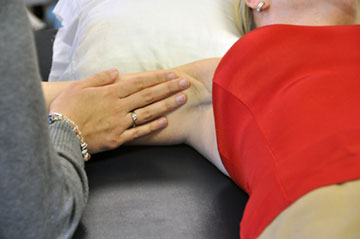Complex Decongestive Physical Therapy
By Ken Morris, PT, DPT, CMTPT
 Lymphedema. As clinicians, we know and understand what can happen when the natural drainage of the lymphatic system is impaired, often by cancer treatment, trauma or genetic predisposition.
Lymphedema. As clinicians, we know and understand what can happen when the natural drainage of the lymphatic system is impaired, often by cancer treatment, trauma or genetic predisposition.
We’ve seen patients suffer from fluid building up in their tissues. It’s painful. They face a threat of infection. The pressure and stiffness often negatively impact their quality of life. And that doesn’t begin to address how they generally feel about their appearance as their limbs swell from the fluid buildup. They do Google searches and read that it’s something that may never go away. And it scares them.
But it doesn’t have to. There may not be a panacea cure for lymphedema, but there are options that have proven results in helping patients manage the condition.
Physical therapy programs – specifically Complex Decongestive Physical Therapy administered by a licensed physical therapist – offer ways for patients living with lymphedema to keep the lymphatic fluid moving and get as close to living an active life as possible.
At the Tidewater Physical Therapy clinics that offering this treatment, we start with education, explaining exactly what lymphedema is to patients newly living with the condition, and why Complex Decongestive Physical Therapy can help them.
Lymphedema occurs generally in the arms and legs due to a blockage in the lymphatic system. It’s caused when the normal drainage of fluid is hindered by a blockage or cut in the lymph nodes in the groin area or the armpit. While sometimes hereditary, lymphedema is usually the result of blockages caused by infection, cancer and scar tissue from radiation therapy or the surgical removal of lymph nodes.
About a third of women whose lymph nodes are dissected during breast cancer treatment will develop lymphedema. A colleague recently shared the story of a young woman who conquered breast cancer, but ultimately developed lymphedema.
Physical therapy was not a treatment this patient thought she needed in her cancer recovery, but after utilizing Complex Decongestive Therapy for her limb swelling, she was able to return to her normal daily activities.
Physical therapists use a variety of methods to encourage lymph flow and reduce swelling. Once swelling decreases, we help patients take over their own care by creating a safe exercise program to do at home, providing tips for staying on a proper diet that will decrease fluid buildup in the tissues, and helping obtain compression garments to manage symptoms in the future.
Even if lymphedema doesn’t develop after lymph node removal, a prescribed exercise program to improve one’s overall fitness can minimize future risks.
As with every patient we work with, detailed and regular communication is maintained with physicians. Patients with poor heart, lung or kidney issues, and those with these issues combined with the effects of poor venous flow, can present like lymphedema. Ensuring all members of a patient’s healthcare team are fully aware of developments is vital.
Early intervention is key to helping any swelling that develops from getting worse.
 Ken Morris, PT, DPT, CMTPT is the Clinical Director of the Tidewater Physical Therapy Hidenwood location in Newport News. Physical therapists trained in lymphedema management are available at Tidewater Physical Therapy clinics in Newport News (Hidenwood), Smithfield, Norge and Norfolk (Kempsville). Learn more about Tidewater Physical Therapy at www.tpti.com.
Ken Morris, PT, DPT, CMTPT is the Clinical Director of the Tidewater Physical Therapy Hidenwood location in Newport News. Physical therapists trained in lymphedema management are available at Tidewater Physical Therapy clinics in Newport News (Hidenwood), Smithfield, Norge and Norfolk (Kempsville). Learn more about Tidewater Physical Therapy at www.tpti.com.

